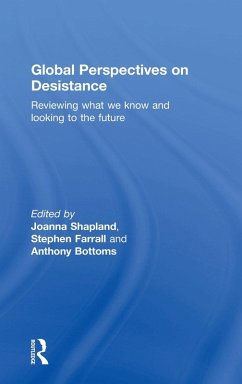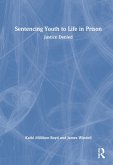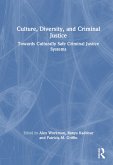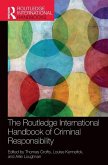Global Perspectives on Desistance
Reviewing What We Know and Looking to the Future
Herausgeber: Shapland, Joanna; Bottoms, Anthony; Farrall, Stephen
Global Perspectives on Desistance
Reviewing What We Know and Looking to the Future
Herausgeber: Shapland, Joanna; Bottoms, Anthony; Farrall, Stephen
- Gebundenes Buch
- Merkliste
- Auf die Merkliste
- Bewerten Bewerten
- Teilen
- Produkt teilen
- Produkterinnerung
- Produkterinnerung
This book is the first to offer a global perspective on global perspective on desistance and bring together leading experts in the field from the UK, Ireland, Netherlands, Sweden, Germany, USA and Australia and draws on a range of international longitudal studies. With contributions from Peggy C. Giordano; Christoffer Carlsson; Deirdre Healy; José Cid & Joel Marti; Rolf Loeber, Magda Stouthamer-Loeber & Lia Ahonen; Edward P. Mulvey & Carol A. Schubert; Arjan Blokland & Niek de Schipper; Torbjørn Skardhamar & Jukka Savolainen; Mark Halsey; Chris Uggen & Lindsay Blahnik; Megan C. Kurlychek, Shaun D. Bushway & Megan Denver; and Fergus McNeill.…mehr
Andere Kunden interessierten sich auch für
![Sentencing Youth to Life in Prison Sentencing Youth to Life in Prison]() Kathi Milliken-BoydSentencing Youth to Life in Prison165,99 €
Kathi Milliken-BoydSentencing Youth to Life in Prison165,99 €![Sexual Assault Kits and Reforming the Response to Rape Sexual Assault Kits and Reforming the Response to Rape]() Sexual Assault Kits and Reforming the Response to Rape161,99 €
Sexual Assault Kits and Reforming the Response to Rape161,99 €![Culture, Diversity, and Criminal Justice Culture, Diversity, and Criminal Justice]() Culture, Diversity, and Criminal Justice168,99 €
Culture, Diversity, and Criminal Justice168,99 €![The Routledge International Handbook of Criminal Responsibility The Routledge International Handbook of Criminal Responsibility]() The Routledge International Handbook of Criminal Responsibility281,99 €
The Routledge International Handbook of Criminal Responsibility281,99 €![An Ontology of Organized Crime An Ontology of Organized Crime]() Stephen SchneiderAn Ontology of Organized Crime181,99 €
Stephen SchneiderAn Ontology of Organized Crime181,99 €![Exploring Vulnerability in the Criminal Justice System in England and Wales Exploring Vulnerability in the Criminal Justice System in England and Wales]() Laura FarrugiaExploring Vulnerability in the Criminal Justice System in England and Wales179,99 €
Laura FarrugiaExploring Vulnerability in the Criminal Justice System in England and Wales179,99 €![The Re-Evolution of American Street Gangs The Re-Evolution of American Street Gangs]() The Re-Evolution of American Street Gangs106,99 €
The Re-Evolution of American Street Gangs106,99 €-
-
-
This book is the first to offer a global perspective on global perspective on desistance and bring together leading experts in the field from the UK, Ireland, Netherlands, Sweden, Germany, USA and Australia and draws on a range of international longitudal studies. With contributions from Peggy C. Giordano; Christoffer Carlsson; Deirdre Healy; José Cid & Joel Marti; Rolf Loeber, Magda Stouthamer-Loeber & Lia Ahonen; Edward P. Mulvey & Carol A. Schubert; Arjan Blokland & Niek de Schipper; Torbjørn Skardhamar & Jukka Savolainen; Mark Halsey; Chris Uggen & Lindsay Blahnik; Megan C. Kurlychek, Shaun D. Bushway & Megan Denver; and Fergus McNeill.
Hinweis: Dieser Artikel kann nur an eine deutsche Lieferadresse ausgeliefert werden.
Hinweis: Dieser Artikel kann nur an eine deutsche Lieferadresse ausgeliefert werden.
Produktdetails
- Produktdetails
- Verlag: Taylor & Francis
- Seitenzahl: 304
- Erscheinungstermin: 20. April 2016
- Englisch
- Abmessung: 234mm x 156mm x 19mm
- Gewicht: 626g
- ISBN-13: 9781138850996
- ISBN-10: 1138850993
- Artikelnr.: 43917562
- Herstellerkennzeichnung
- Libri GmbH
- Europaallee 1
- 36244 Bad Hersfeld
- gpsr@libri.de
- Verlag: Taylor & Francis
- Seitenzahl: 304
- Erscheinungstermin: 20. April 2016
- Englisch
- Abmessung: 234mm x 156mm x 19mm
- Gewicht: 626g
- ISBN-13: 9781138850996
- ISBN-10: 1138850993
- Artikelnr.: 43917562
- Herstellerkennzeichnung
- Libri GmbH
- Europaallee 1
- 36244 Bad Hersfeld
- gpsr@libri.de
Joanna Shapland is Edward Bramley Professor of Criminal Justice in the University of Sheffield and Director of the Centre for Criminological Research. She was awarded the Outstanding Achievement Award by the British Society of Criminology in 2013 and is Executive Editor of the International Review of Victimology. Stephen Farrall is Professor of Criminology in the Centre for Criminological Research at the University of Sheffield. Stephen also edits the International Series on Desistance and Rehabiliation (published by Routledge). Anthony Bottoms is Emeritus Wolfson Professor of Criminology in the University of Cambridge and Honorary Professor of Criminology in the University of Sheffield. He is also a Fellow of the British Academy. With Joanna Shapland, he co-directs the Sheffield Desistance Study.
Introduction (Joanna Shapland, Stephen Farrall and Anthony Bottoms)
Section I: Agency, structure and desistance from crime
1. Mechanisms underlying the desistance process: Reflections on 'A theory
of cognitive transformation' (Peggy C. Giordano)
2. Human agency, criminal careers and desistance (Christoffer Carlsson)
3. "I've always tried but I hadn't got the willpower": Understanding
pathways to desistance in the Republic of Ireland (Deirdre Healy)
4. Structural context and pathways to desistance (José Cid and Joel Marti)
Section II: Life phases and desistance
5. Key behavioral aspects of desistance from conduct problems and
delinquency (Rolf Loeber, Magda Stouthamer-Loeber, and Lia Ahonen)
6. Learning to desist in early adulthood: the Sheffield Desistance Study
(Anthony Bottoms and Joanna Shapland)
7. Observations from the Pathways to Desistance study: Some issues to
consider in future work on desistance from adolescence to early adulthood
(Edward P. Mulvey and Carol A. Schubert)
8. How important are life-course transitions in explaining desistance?
Examining the extent to which marriage, divorce and parenthood account for
the age-crime relationship in former juvenile delinquents (Arjan Blokland
and Niek de Schipper)
9. Timing of change: Are life course transitions causes or consequences of
desistance? (Torbjørn Skardhamar and Jukka Savolainen)
Section III: Criminal justice and state interventions
10. Understanding desistance in an assisted context: Key findings from
tracking progress on probation (Stephen Farrall)
11. In search of desistance: Notes from an Australian study (Mark Halsey)
12. The increasing stickiness of public labels (Chris Uggen and Lindsay
Blahnik)
13. Understanding and identifying desistance: an example exploring the
utility of sealing criminal records (Megan C. Kurlychek, Shaun D. Bushway
and Megan Denver)
14. The fuel in the tank or the hole in the boat? Can sanctions support
desistance? (Fergus McNeill)
Afterword: diversity or congruence? (Joanna Shapland, Stephen Farrall and
Anthony Bottoms)
Section I: Agency, structure and desistance from crime
1. Mechanisms underlying the desistance process: Reflections on 'A theory
of cognitive transformation' (Peggy C. Giordano)
2. Human agency, criminal careers and desistance (Christoffer Carlsson)
3. "I've always tried but I hadn't got the willpower": Understanding
pathways to desistance in the Republic of Ireland (Deirdre Healy)
4. Structural context and pathways to desistance (José Cid and Joel Marti)
Section II: Life phases and desistance
5. Key behavioral aspects of desistance from conduct problems and
delinquency (Rolf Loeber, Magda Stouthamer-Loeber, and Lia Ahonen)
6. Learning to desist in early adulthood: the Sheffield Desistance Study
(Anthony Bottoms and Joanna Shapland)
7. Observations from the Pathways to Desistance study: Some issues to
consider in future work on desistance from adolescence to early adulthood
(Edward P. Mulvey and Carol A. Schubert)
8. How important are life-course transitions in explaining desistance?
Examining the extent to which marriage, divorce and parenthood account for
the age-crime relationship in former juvenile delinquents (Arjan Blokland
and Niek de Schipper)
9. Timing of change: Are life course transitions causes or consequences of
desistance? (Torbjørn Skardhamar and Jukka Savolainen)
Section III: Criminal justice and state interventions
10. Understanding desistance in an assisted context: Key findings from
tracking progress on probation (Stephen Farrall)
11. In search of desistance: Notes from an Australian study (Mark Halsey)
12. The increasing stickiness of public labels (Chris Uggen and Lindsay
Blahnik)
13. Understanding and identifying desistance: an example exploring the
utility of sealing criminal records (Megan C. Kurlychek, Shaun D. Bushway
and Megan Denver)
14. The fuel in the tank or the hole in the boat? Can sanctions support
desistance? (Fergus McNeill)
Afterword: diversity or congruence? (Joanna Shapland, Stephen Farrall and
Anthony Bottoms)
Introduction (Joanna Shapland, Stephen Farrall and Anthony Bottoms)
Section I: Agency, structure and desistance from crime
1. Mechanisms underlying the desistance process: Reflections on 'A theory
of cognitive transformation' (Peggy C. Giordano)
2. Human agency, criminal careers and desistance (Christoffer Carlsson)
3. "I've always tried but I hadn't got the willpower": Understanding
pathways to desistance in the Republic of Ireland (Deirdre Healy)
4. Structural context and pathways to desistance (José Cid and Joel Marti)
Section II: Life phases and desistance
5. Key behavioral aspects of desistance from conduct problems and
delinquency (Rolf Loeber, Magda Stouthamer-Loeber, and Lia Ahonen)
6. Learning to desist in early adulthood: the Sheffield Desistance Study
(Anthony Bottoms and Joanna Shapland)
7. Observations from the Pathways to Desistance study: Some issues to
consider in future work on desistance from adolescence to early adulthood
(Edward P. Mulvey and Carol A. Schubert)
8. How important are life-course transitions in explaining desistance?
Examining the extent to which marriage, divorce and parenthood account for
the age-crime relationship in former juvenile delinquents (Arjan Blokland
and Niek de Schipper)
9. Timing of change: Are life course transitions causes or consequences of
desistance? (Torbjørn Skardhamar and Jukka Savolainen)
Section III: Criminal justice and state interventions
10. Understanding desistance in an assisted context: Key findings from
tracking progress on probation (Stephen Farrall)
11. In search of desistance: Notes from an Australian study (Mark Halsey)
12. The increasing stickiness of public labels (Chris Uggen and Lindsay
Blahnik)
13. Understanding and identifying desistance: an example exploring the
utility of sealing criminal records (Megan C. Kurlychek, Shaun D. Bushway
and Megan Denver)
14. The fuel in the tank or the hole in the boat? Can sanctions support
desistance? (Fergus McNeill)
Afterword: diversity or congruence? (Joanna Shapland, Stephen Farrall and
Anthony Bottoms)
Section I: Agency, structure and desistance from crime
1. Mechanisms underlying the desistance process: Reflections on 'A theory
of cognitive transformation' (Peggy C. Giordano)
2. Human agency, criminal careers and desistance (Christoffer Carlsson)
3. "I've always tried but I hadn't got the willpower": Understanding
pathways to desistance in the Republic of Ireland (Deirdre Healy)
4. Structural context and pathways to desistance (José Cid and Joel Marti)
Section II: Life phases and desistance
5. Key behavioral aspects of desistance from conduct problems and
delinquency (Rolf Loeber, Magda Stouthamer-Loeber, and Lia Ahonen)
6. Learning to desist in early adulthood: the Sheffield Desistance Study
(Anthony Bottoms and Joanna Shapland)
7. Observations from the Pathways to Desistance study: Some issues to
consider in future work on desistance from adolescence to early adulthood
(Edward P. Mulvey and Carol A. Schubert)
8. How important are life-course transitions in explaining desistance?
Examining the extent to which marriage, divorce and parenthood account for
the age-crime relationship in former juvenile delinquents (Arjan Blokland
and Niek de Schipper)
9. Timing of change: Are life course transitions causes or consequences of
desistance? (Torbjørn Skardhamar and Jukka Savolainen)
Section III: Criminal justice and state interventions
10. Understanding desistance in an assisted context: Key findings from
tracking progress on probation (Stephen Farrall)
11. In search of desistance: Notes from an Australian study (Mark Halsey)
12. The increasing stickiness of public labels (Chris Uggen and Lindsay
Blahnik)
13. Understanding and identifying desistance: an example exploring the
utility of sealing criminal records (Megan C. Kurlychek, Shaun D. Bushway
and Megan Denver)
14. The fuel in the tank or the hole in the boat? Can sanctions support
desistance? (Fergus McNeill)
Afterword: diversity or congruence? (Joanna Shapland, Stephen Farrall and
Anthony Bottoms)









